Kinnikinic: Ready to Transplant and Prune into Bonsai Form [Bonsai]
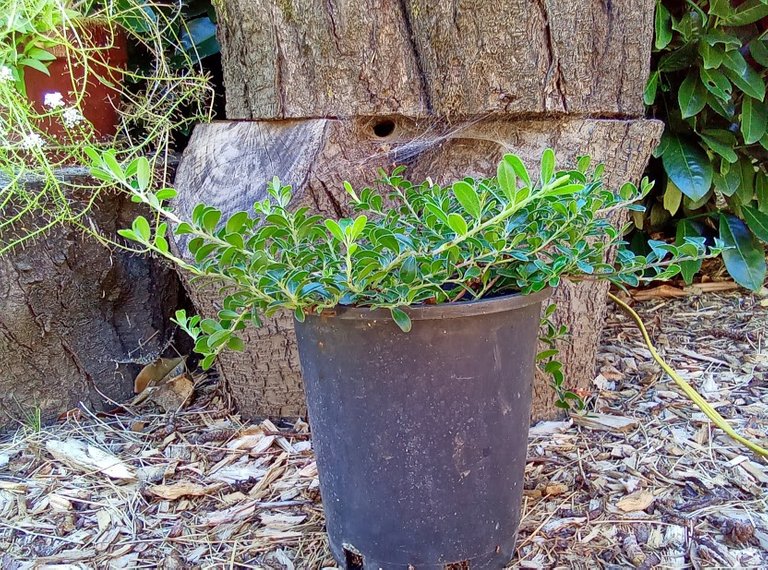
Working with Kinnikinic is a chance for me to learn about growing a new species of plant, and grow in my abilities.
This plant has a natural habit for low-growing branches with small leaves. It is considered a native plant in my area, and beneficial for wildlife habitats. They are best adapted for growing on hillsides where the ground tends to let rainfall run over the soil top instead of saturating deep down.
My hope is that that these traits will enable it to become a super bonsai.
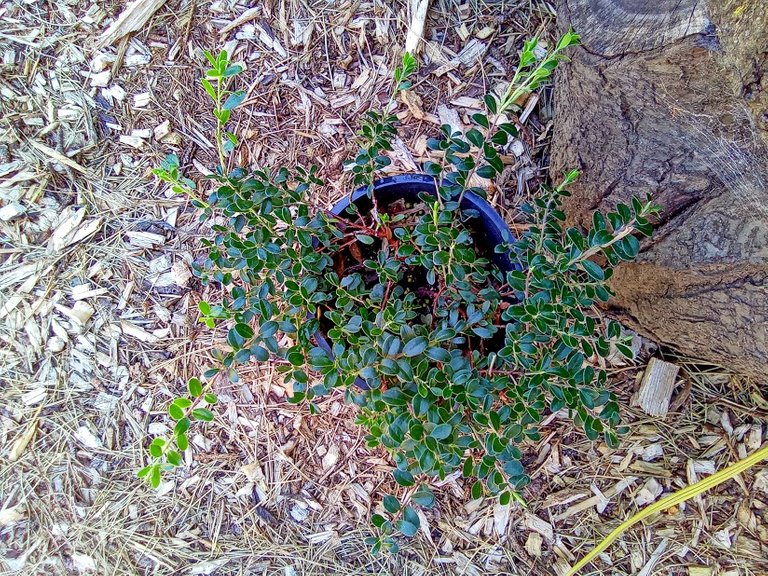
These photos were collected on August 8, 2020.
I've been caring for this plant for nearly six months since I purchased it from a plant nursery.
Now that the plant is showing signs of vigorous new growth, and the branches starting to overlap and compete for space, I figured this was a good day to prune it into shape.
Historical Information
ID: 0052
Nickname: Unnamed
Type: Kinnikinic
Age: 2 years, estimated.
Grown: Nursery Stock
Last repotting: October 2, 2020
Wired: October 2, 2020
Pruning
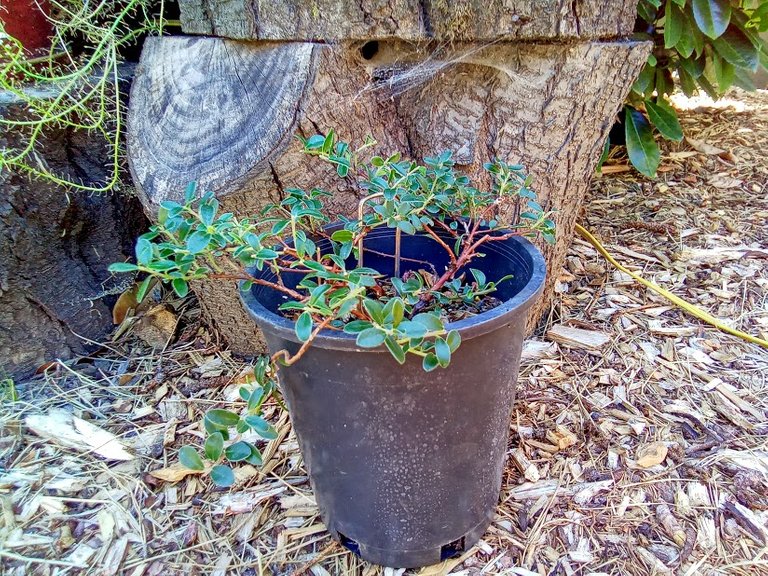
First I trim off the dead and dying branches and leaves.
Remove branches blocking sunlight to the center trunk, to allow sunlight in.
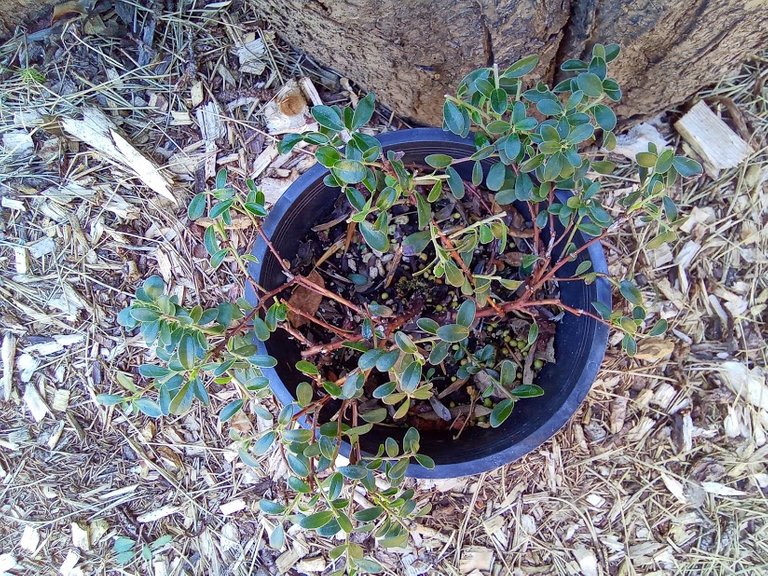
New shoots I noticed were developing out of the soil, directly from the roots. I pinched off any little suckers forming at the base, and allowed two main trunks to remain, which seem to the dominant elements of the plant.
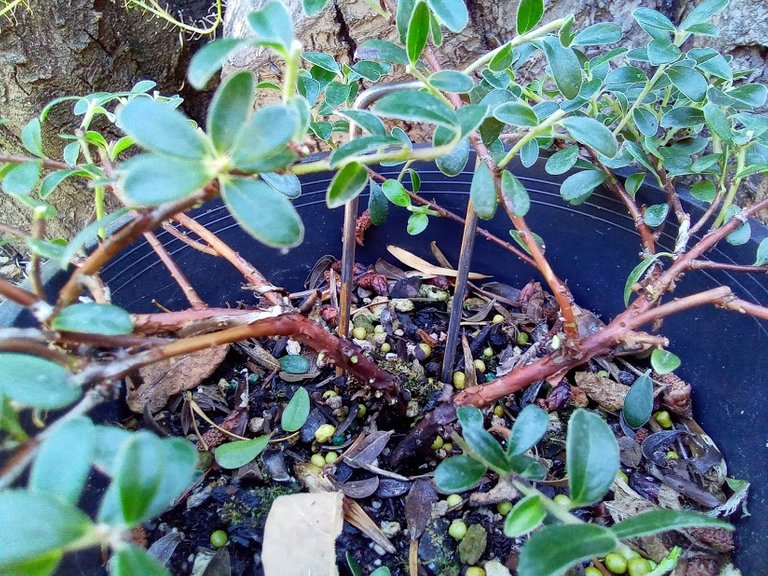
The branches here have a lovely motion shape. It moves in a nice half spiral, the whirlpool churns and spins.
Anything that displays motion from a plant that sits still is more interesting to look at. This can make the plant seem more actively alive.

On the other side, the sub-branching is more evident. I take notice that the wood of this plant tends to form a papery bark that peels away.

Once trailing branch, I decided to leave alone. Perhaps by letting it dangle downward, I can promote new shoots to form along it's length. It has an meandering bend and twist, which also can add interest and value to the final design.
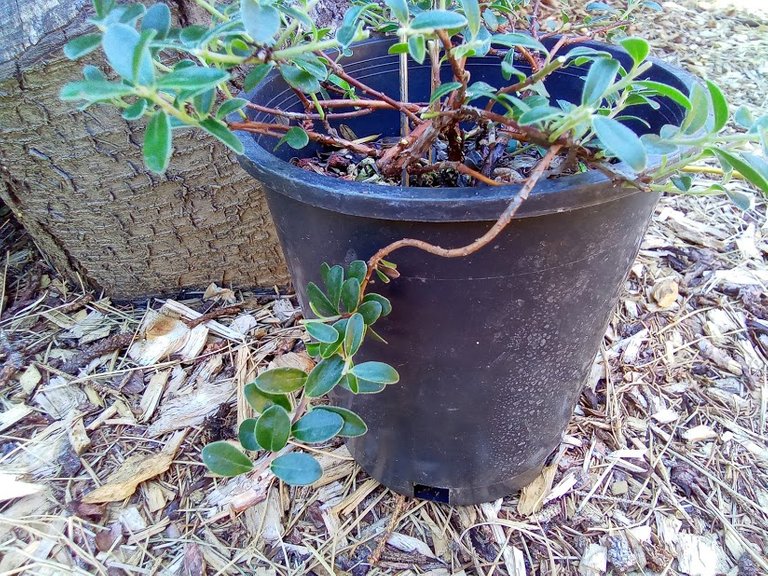
A couple months go by, and I'm now interested in learning how well the tree is doing underneath the soil.
I do not know if this type of soil is well suited for Kinnikinic to live in. It holds a lot of moisture, and has lot of natural compost.
In my experience, most native shade plants in our area do better if allowed to grow inside lots of well-rotted bark and leaf compost.
Checking the Roots
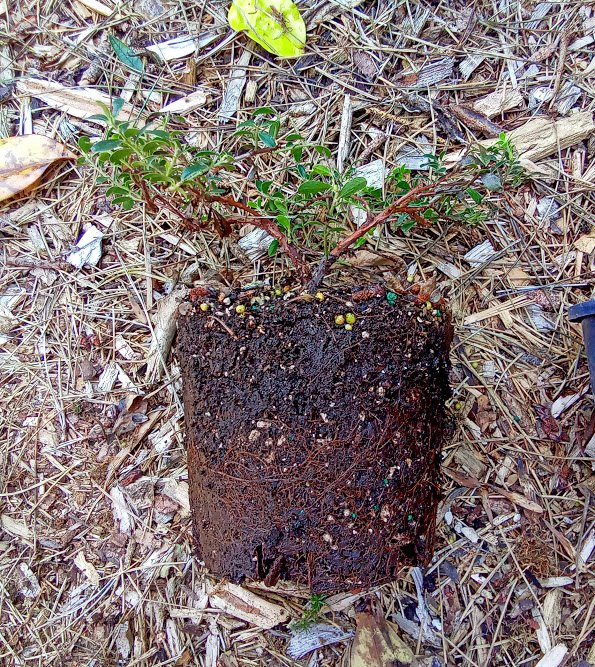
Now it is October, and I finally decided to unearth the plant to examine the soil and roots.
The soil looks very black and rich. The fertilizer balls on top are adding heavy amounts of nitrogen to the soil. The foliage does not look burned. I am assuming the plant is in good health.
The roots look like very thin threads. They ratio of roots to soil mass is very low.

Using a chopstick I carve the soil out away from the roots. In this way, I can feel how loose the soil is, and how the gentle roots are barely holding their shape.
A discovery is made.
We have not one, but two separate plants!
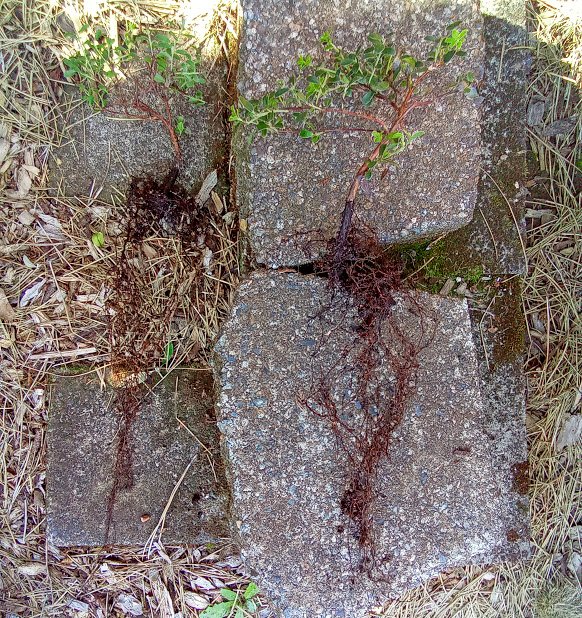
Laying them out, I take notice of how long the actual roots are, where at what height most of the roots are forming.
There are some short structural roots at the top.
Various long roots run parallel downward, about as long as the pot was tall.
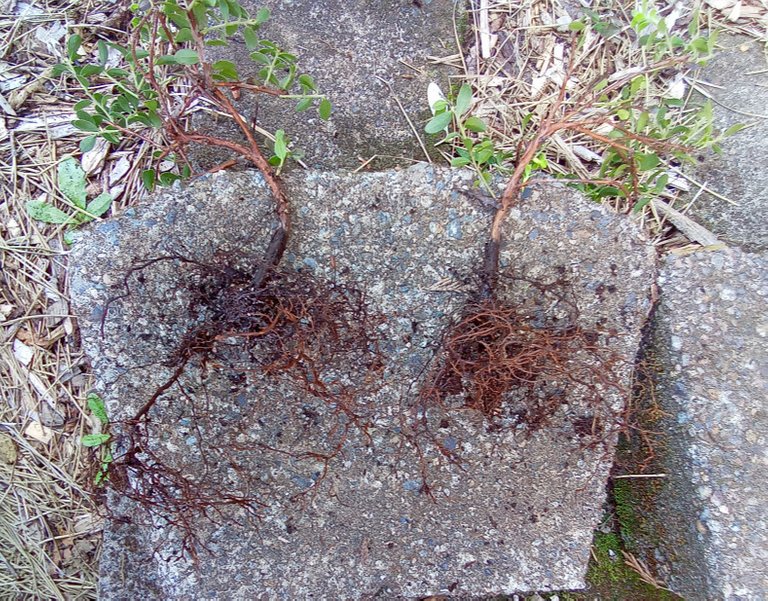
By pruning the roots to about half-length, I am confident that this is still less than 1/3 of the total root mass removed.
The trees should now be able to fit into a more shallow bonsai pot.
A bonsai pot will promote better drainage, and hopefully prevent the roots from rotting over the winter rain season.
Crossing my fingers, I hope I have not pruned off too much or distressed the trees too much. If they are healthy, the trees should have enough stored vigor to withstand a certain amount of transplant stress during this time of year.
Preparing the Bonsai Pot

This simple black bonsai pot has two large drainage holes.
Using a screen, I cover the holes to prevent bonsai soil from spilling out the bottom.
Wires are used to secure the screen into place, so it doesn't slide off the holes.
Additional lengths of wire are inserted to help hold the fragile trees solidly in place. Roots tend to grow stronger if the trees are not swaying or tipping over in the wind.
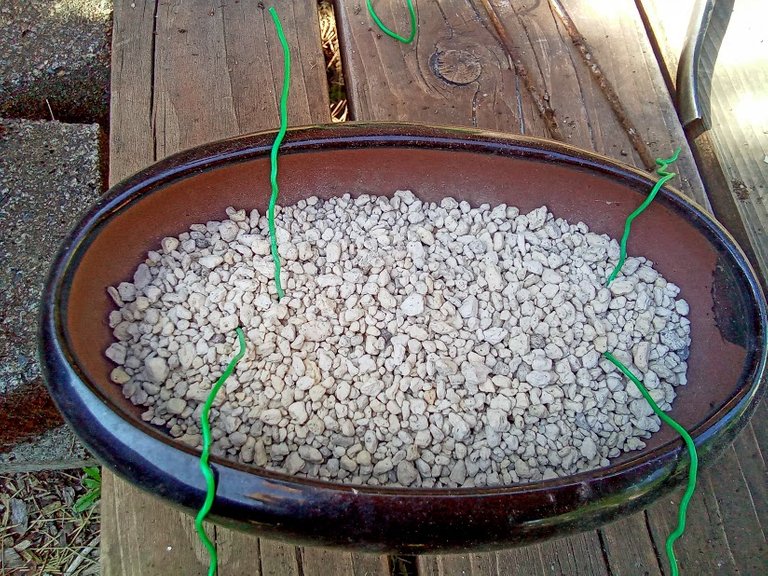
The base is filled with a shallow layer of pumice. This will both aerate the roots and provide pockets of moist air. This will allow roots to dry out on a daily basis, which is good for soil and root health.
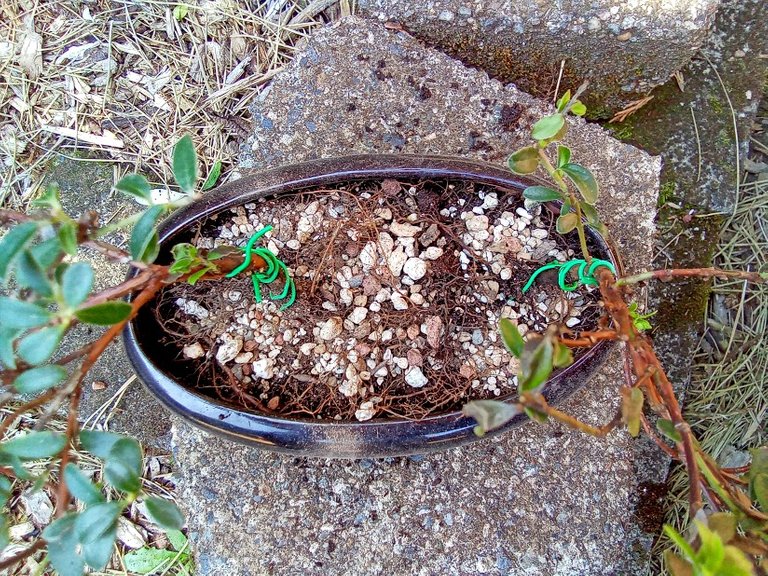
Over the pumice, I place the trees, and cushion the roots with the original black organic soil. It is not good to deprive the trees of the soil they were growing in. They have grown accustomed to supplying their nutritional needs from that soil to stay healthy.
On top, I toss a thin layer of bonsai soil which includes red lava rock, akadama clay, and pumice. These layer will start to acclimate the trees to start to get used to bonsai soil as a replacement source for water, air, and nutrient cavities. Eventually I would like the trees to have less organic soil, and more bonsai soil to promote better small root formation.
The roots are wreathed into a basket form around the outside, interweaving with the roots of the other neighbor tree.
The wires are wrapped around the trunks to hold the trees upright, and to help prevent them from shifting around in the wet soil.
For the next year, I am actually hoping these trees start to become slightly root-bound. They desperately need some added root-strength to combat their current flimsy nature.
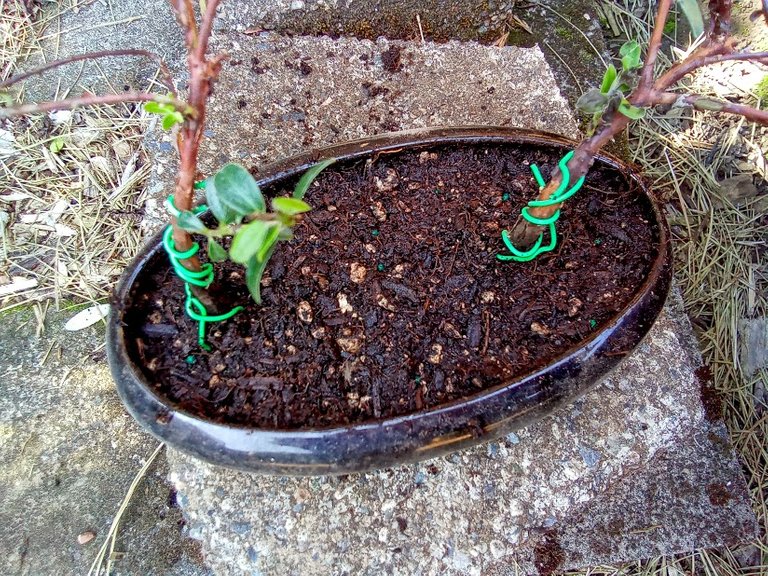
More of the original soil is used to completely cover the roots, to prevent moisture loss and protect from direct sunlight.
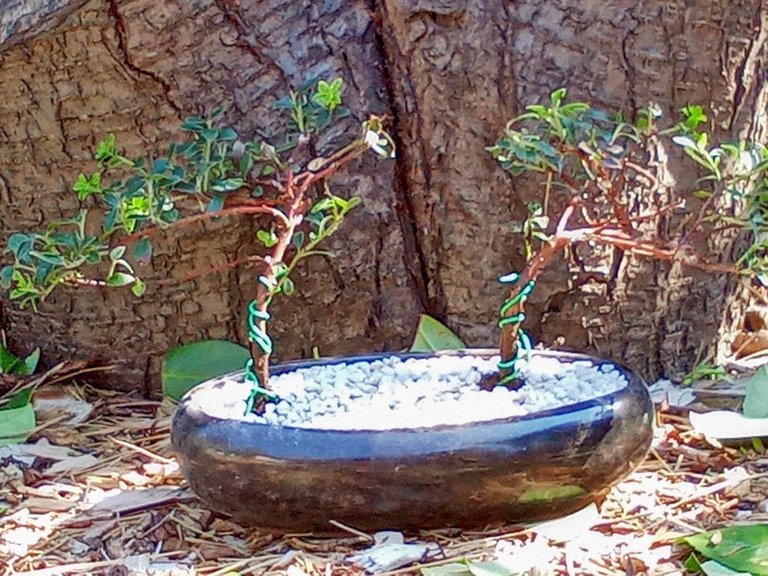
A top layer of pumice is applied over the soil. It makes the soil look more neat and clean. I also prefer the pure white to contrast the black pot. This combination will magnify the color of the reddish bark and the vibrant green leaves.
The placement of the trees shows evidence of how the foliage of these two were once combined to form a single circular canopy. Now they are more distanced, forming two separated halves of a whole.
New branches will be encouraged to fill in the void, adding better balance to each tree.
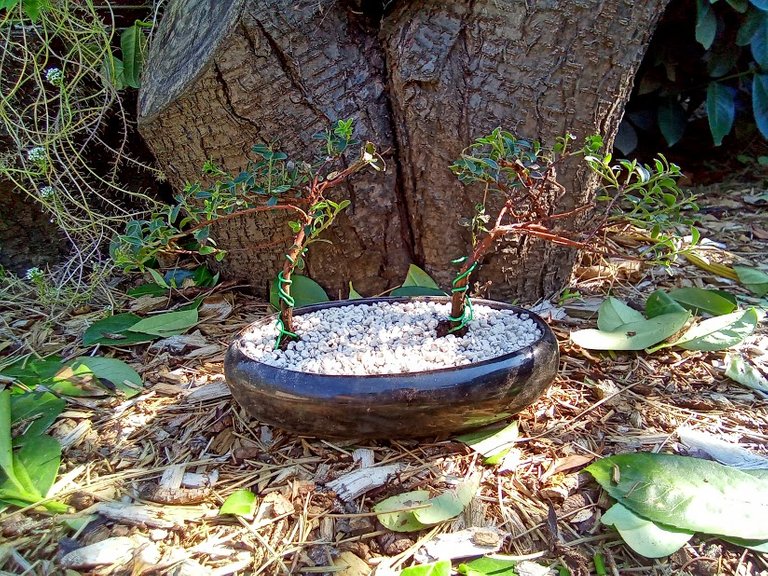
And so, there were have it.
Into the partial shade, it will be positioned to grow for the next month or so.
We are having an extremely warm, sunny October, and that is good thing. Many plants in my garden are springing back to life with new green leaves, even after the wildfires smoke forced most plants into dropping their leaves early.
Photos in this post are all #originalworks by @creativetruth, unless stated otherwise.
Find me on discord and chat with other tree growers, bonsai enthusiasts, and gardeners.

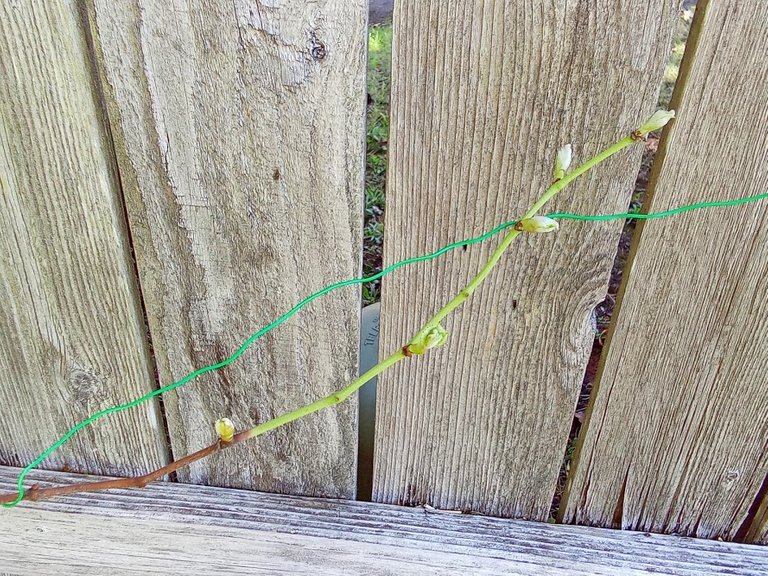
Post Beneficiaries:
- 1% @mendezand
- 1% @cryptopie
This is my way of thanking each of you for your friendship and support. By sharing my talents on Hive, I can also share to help with your needs.
Let my success also grant you some happiness too.

Wow! Hope your twin trees do well.
I’ve featured your post in The Lotus Garden newsletter, which will be published tomorrow, and selected you to be the recipient of the 5% beneficiary.
Curated for #naturalmedicine (by @minismallholding) - join our community here.
The Lotus Garden is a newsletter supporting content relevant to Homesteaders & supported by Natural Medicine. Earn LOTUS & HIVE for your #homesteading content!
About II Discord II Community
Nice gesture. Thank you for your daily curation surfing.
What an interesting name 😉. I thought it was a purslane but when I look closely this one has tougher branches.
Is it alright to put pumice stones on all potted plants? I noticed some of my plants are turning brown and wilt could be because of too much watering.
Pumice would make a good bottom layer for any plant that develops sprawling/invasive roots. Trees, shrubs, vines, mint, etc.. The pumice layer will prevent plants from becoming rootbound from a single long taproot, and force it to develop more divisions of fine feeder roots near the surface instead.
The strategies I show are more designed for creating bonsai trees.
Usually the more delicate/tender the plant, the more soft the soil should be. Especially herbs I am learning prefer rich organic soil.
It is already looking great @creativetruth, it just needs a lot of growing and thickening of the branches and stem. :D